
views
Conducting Interviews and Research

Contact sources for the article. Contact your sources as far in advance as possible, as this will make arranging interviews with them easier. Try to have at least 2-3 primary sources for the article. Go for sources that are on opposite sides of a topic or subject so your article is well-rounded. Your sources should be experts in the field your article is focusing on, such as a certified professional, a professor, or an academic. You can use sources that have extensive experience or background in a field that relates to your article. Sources like a witness to an event can also be useful, especially if they have first-hand experience of the topic you are covering.
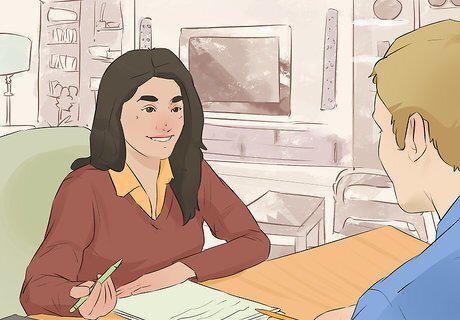
Conduct interviews with your sources. If possible, try to arrange in-person interviews with your sources in a comfortable, quiet setting, such as the person’s office, a coffee shop, or the person’s home. If you cannot arrange an in-person interview, you can talk to the person by phone or over web cam. Prepare interview questions beforehand and ask your sources if you can record the interview so you have their quotes on the record. You may need to conduct more than 1 interview with your sources, especially if they are a major source for the article. You can also send follow-up questions to your sources as needed. You will need to transcribe your interviews by typing them up to ensure you quote your sources correctly. Having transcriptions will also make fact checking your article and backing up your sources much easier.

Look up public information on the topic at your local library and online. You will likely need to find out information on the topic or subject that is factual and accurate. Do a search for academic reports and articles on your topic at your local library. Look for online sources that are peer reviewed on an academic database or an official government website. Make sure you cite the information properly in your article by noting the name or organization that provided the information. You should have credible sources to back up any claims or arguments made in the article.

Fact check any statistics or numbers before you use them in the article. If you are leaning on statistics, data, or numerical information in the article, trace them back to a credible source to ensure they are correct. Make sure you refer to the source in your article so the reader knows you have fact checked the information. If you are writing the newspaper article for an editor, they may require you to provide a list of your sources for the article to show you have fact checked your work.
Structuring the Article
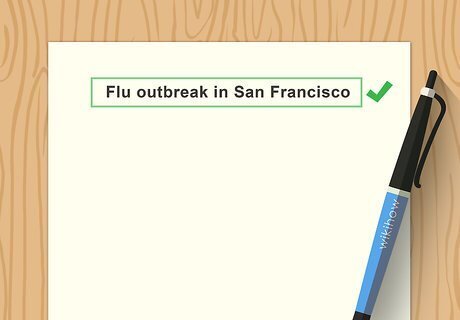
Create an engaging, informative headline. The headline should grab the reader’s attention and give them a taste of what the article is about. A good rule of thumb is to tell the reader the “what” and “where” in the headline. Keep the headline short and clear, perhaps as brief as 4-5 words. For example, you may create a headline like, “Teen Girl Missing in Okotoks” or “Congress Stalls on Family Planning Bill.” In some cases, it may be easier to save the headline for last, after you have written the article, so you know what the focus of the article is and can sum it up clearly.

Open the article with a “lead” first sentence. The lead, also spelled "lede,” contains the story's most essential details. The lead should briefly answer, “Who,” “What,” “When,” “Where,” “Why,” and “How” for the reader. It should also hook the reader in and encourage them to keep reading. For example, you may write a lead like, "An outbreak of flu in San Francisco has led to 3 elementary school closings this week, according to school officials." Or, "A missing girl originally from Okotoks was found Monday in an abandoned cabin in the Minnetonka area, according to local police."

Place information chronologically, starting with the most current, important details. Readers should be able to skim through the first section in the article and get the necessary information about the topic. Provide current, up to date information about the topic in the first 1-2 paragraphs of the article. This is known as the inverted pyramid approach. For example, you may write, “10-12 students have been diagnosed with the flu and health officials fear it could continue to spread if it is not contained.”
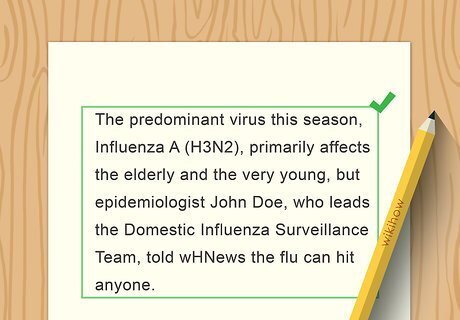
Expand on key details in the rest of the article. This is where you answer the questions, “Why” and “How” in more detail, providing the reader with in-depth coverage. You may provide detailed background on the subject or briefly discuss a past timeline of events that relate to the topic or incident. Keep each paragraph to no more than 2-3 sentences so the reader can follow along easily. For example, you may write, “The teen girl was reported missing on Friday afternoon by her mother after she did not come home from a study date at a friend’s house. She is the second girl to be reported missing in the past 2 weeks from the Okotoks area.”
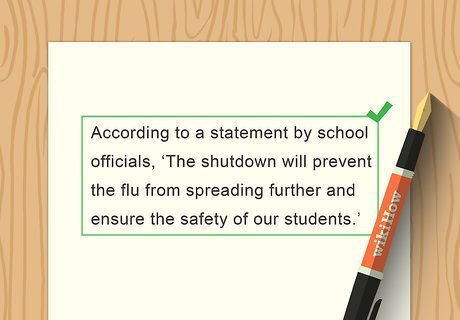
Include at least 2-3 supporting quotations from sources. Put at least 1 strong supporting quote in the first section of the article, as well as 1-2 more in the secondary sections of the article. Use quotes that support any information you provide that is not common knowledge. Stick to quotes that are short, clear, and informative for readers. Always attribute the quotes to a source when you include them in the article. For example, you may write, “‘The girl is shaken, but does not appear to have any serious injuries,’ stated local Police Chief Wilborn.” Or you may write, “According to a statement by school officials, ‘The shutdown will prevent the flu from spreading further and ensure the safety of our students.’” Avoid using long quotes or more than 4 quotes in the article, as the reader may get confused or lost if there are too many quotations.
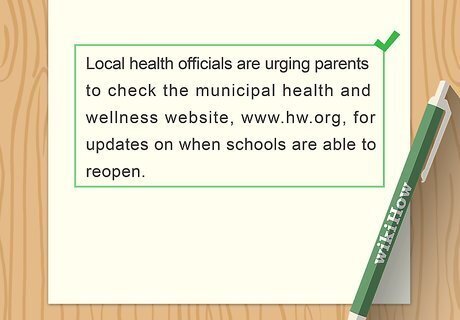
End with an informative quote or a link to more information. Wrap up the article by including a quote that feels impactful and leaves the reader with a sense of understanding. You can also include a link to an organization’s website or event if the article focuses on the organization. For example, you may write, “The girl’s mother expressed relief for her daughter and concern about her community, noting, ‘I just hope no other girls go missing in this area.’” Or you may write, “Local health officials are urging parents to check the municipal health and wellness website, www.hw.org, for updates on when schools are able to reopen.”
Creating the Appropriate Voice and Tone
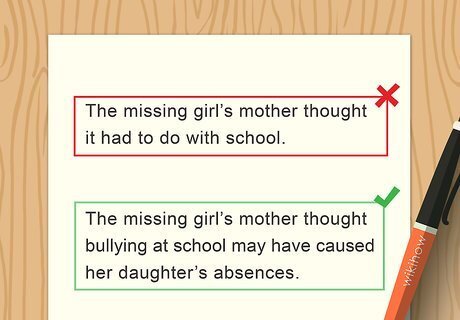
Use specific, clear language that is easy to follow. Avoid vague language or general statements, as they will not be useful for the reader. Instead, use language that is simple and clear so the article is accessible for all readers. Keep your sentences no longer than 2-3 lines and break up any sentences that are too long or run-on. For example, rather than write, “The missing girl’s mother thought it had to do with school,” you may write, “The missing girl’s mother thought bullying at school may have caused her daughter’s absences.”

Write in the active, third person voice. The active, rather than passive, voice places the subject of the sentence first, making it more immediate and informative. Most newspaper articles are written in the third person so they remain objective and do not present a personal or subjective perspective. For example, rather than write, “A press conference will be held by local police tomorrow to address the missing girls and the public’s concerns,” you may write, “Local police will address the missing girls and the public’s concerns in a press conference tomorrow.”

Maintain an objective, informative tone in the article. A newspaper article should not show any bias or have any stated opinions about the topic. Instead, it should present a factual account of the event or incident. Avoid using hyperbolic language and do not exaggerate any details in the article. For example, if you're writing about two political candidates running against each other in an election, present both candidates in an equal light, rather than giving extra details about 1 candidate. If you're writing an op-ed piece, it's okay to mix some of your opinions with the facts.
Polishing the Article

Read the article aloud. Once you have completed a draft of the article, read it aloud to listen to how it sounds. Notice if it answers the 5 W’s and 1 H -- “Who, what, where, when, why, and how” -- and if it it is easy to follow. Make sure your quotes are clear when read aloud and that they are not too long or convoluted. Reading the article aloud can also help you catch any spelling, grammar, or punctuation errors.

Show the article to others for critique and feedback. Ask friends, family, mentors, and instructors to read the article. Pose questions about whether or not the article was easy to follow and understand. Find out if they were left with a clear picture of the subject matter and if they felt the article maintained an objective, factual tone throughout. For example, you may ask others questions like, “Were you able to understand what happened, based on the information in the article?” “Was the language clear and easy to follow?” “Was the article well supported with sources and quotes?”

Revise the article for voice, tone, and length. Once you have received feedback on the article, take the time to revise it so it is at its best. Adjust any confusing sentences or sections. Make changes to the language so the tone is objective and informative. Check that the article is clear and to the point, running no longer than 5-10 paragraphs. If you are writing the newspaper article for a class, make sure it falls within the prescribed word limit for the assignment. Anderson Cooper Anderson Cooper, Journalist & Political Correspondent Carve out a niche by gravitating towards underreported stories. "I personally tend to be drawn to stories that aren't paid much attention to, or stories that aren't on people's radar."


















Comments
0 comment